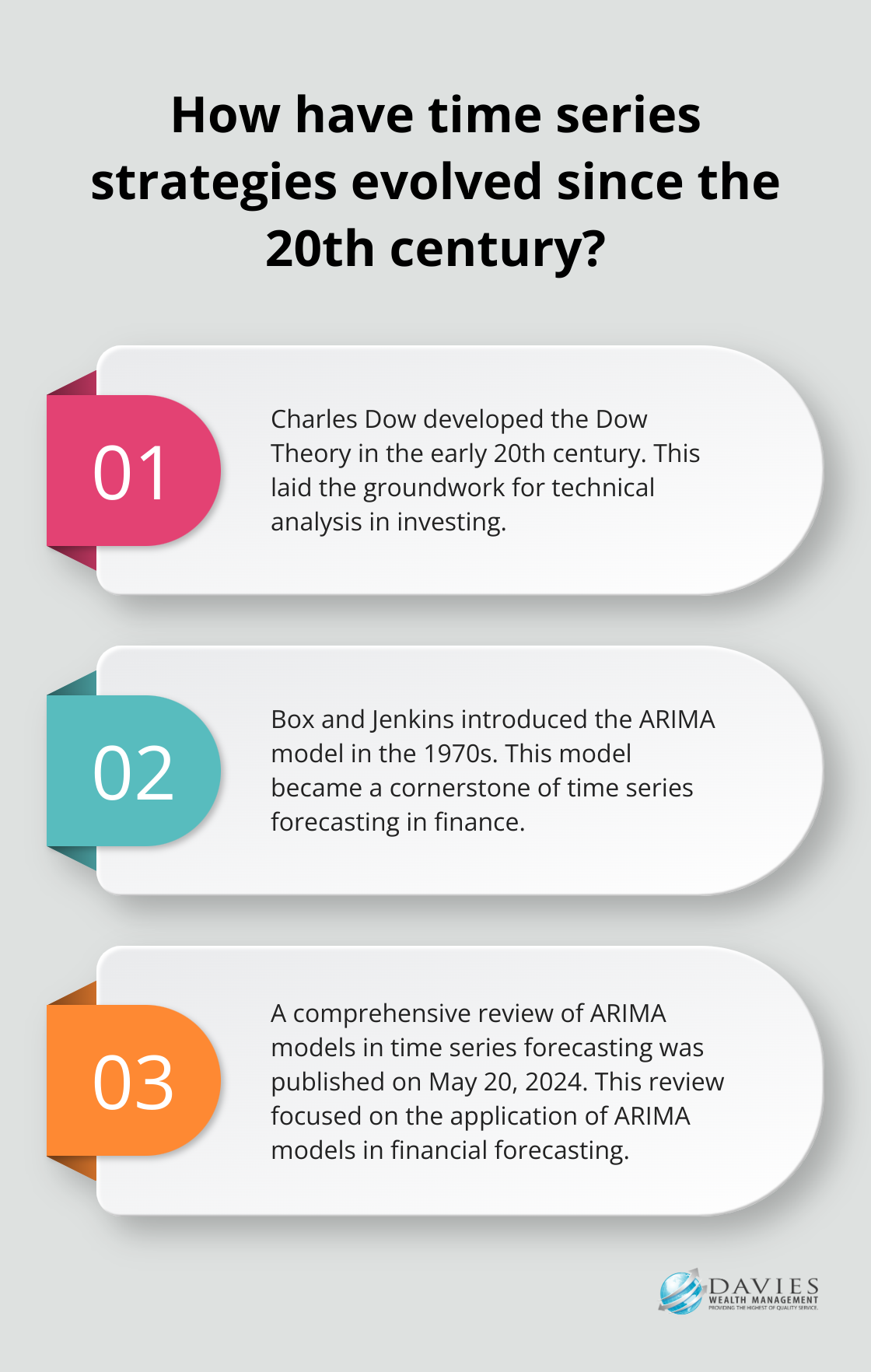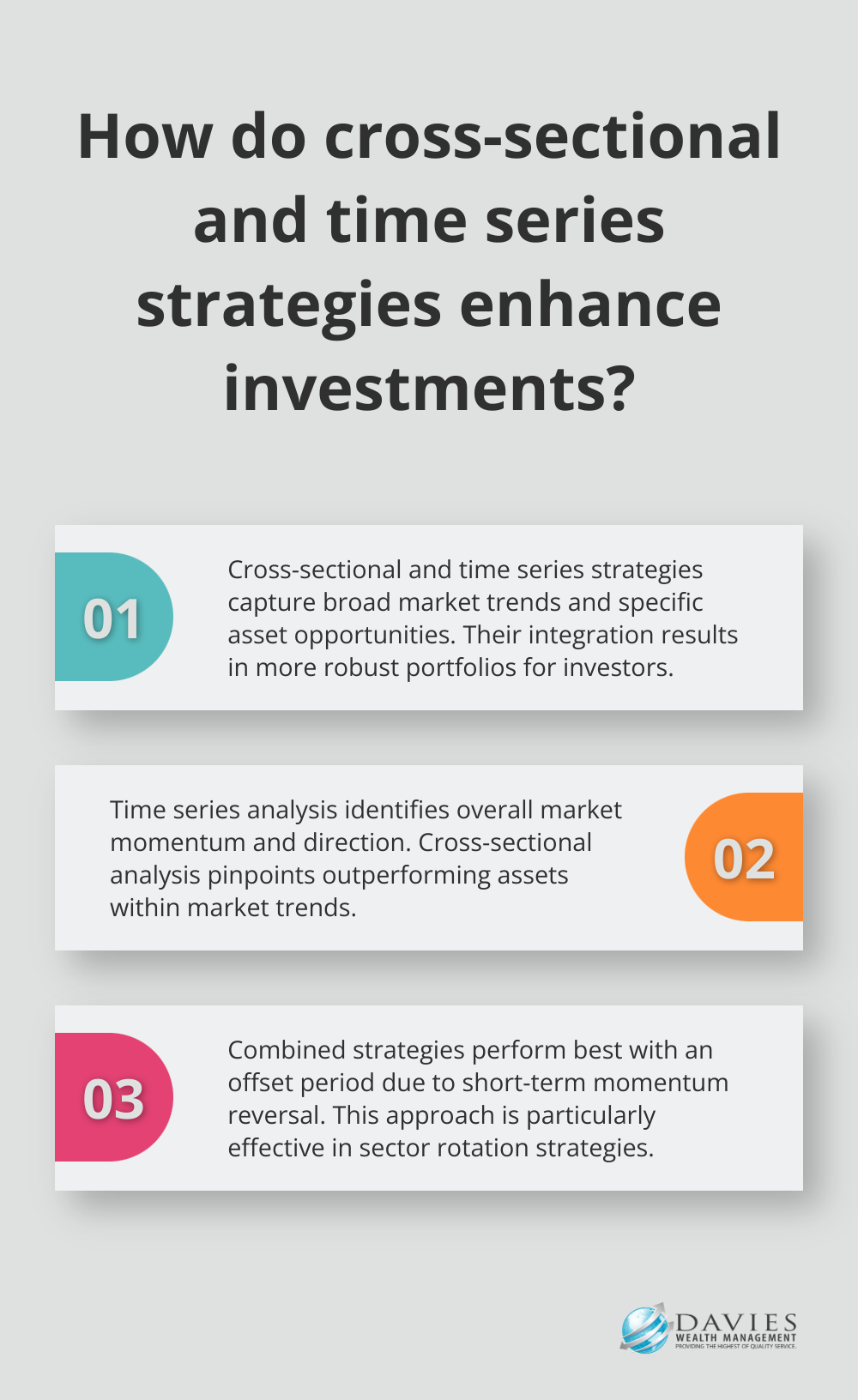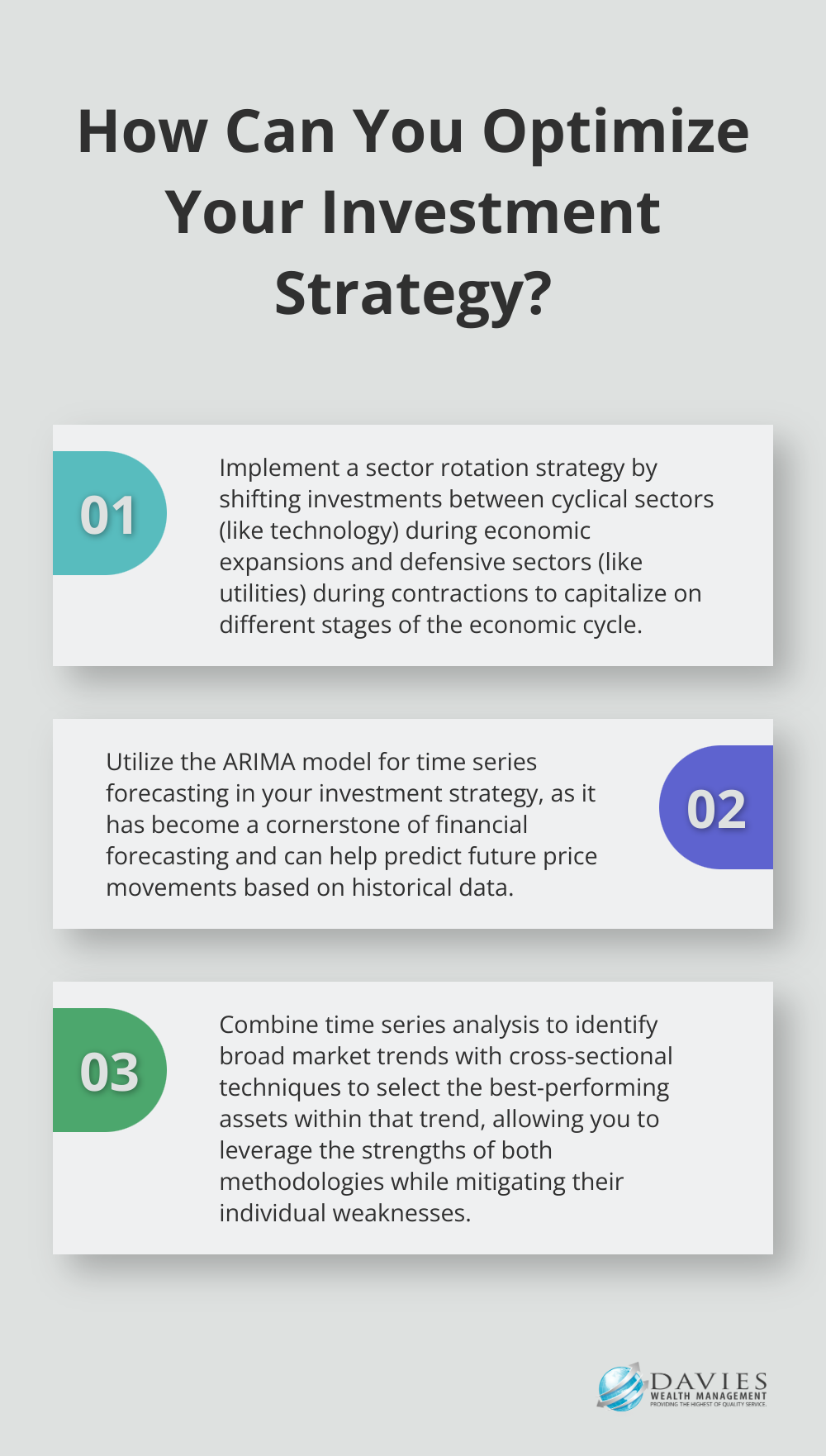At Davies Wealth Management, we’re constantly exploring innovative approaches to portfolio management. Dissecting investment strategies in the cross section and time series is a critical aspect of our analytical process.
This blog post will delve into the intricacies of cross-sectional and time series investment strategies, examining their unique characteristics, advantages, and potential limitations. We’ll also explore how combining these approaches can lead to more robust portfolio construction and risk management techniques.
What Are Cross-Sectional Investment Strategies?
The Mechanics of Cross-Sectional Analysis
Cross-sectional analysis is a type of analysis where an investor, analyst or portfolio manager compares a particular company to its industry peers. These strategies typically rank assets based on specific characteristics or factors, such as financial ratios, growth rates, or other quantitative metrics. For example, a common cross-sectional strategy might rank stocks based on their price-to-earnings (P/E) ratio, with the assumption that lower P/E stocks are undervalued and may outperform in the future.

One of the most widely used cross-sectional strategies is the value investing approach. This strategy, popularized by Benjamin Graham and Warren Buffett, looks for securities with prices that are unjustifiably low based on their intrinsic worth. A study by Fama and French (published in the Journal of Financial Economics) found that value stocks have historically outperformed growth stocks over long periods.
Sector Rotation and Momentum
Sector rotation is another popular cross-sectional strategy. This investment strategy involves shifting investments from one industry sector to another in response to the stages of the economic cycle. For instance, during economic expansions, cyclical sectors like technology or consumer discretionary might receive preference, while defensive sectors like utilities or healthcare might take precedence during economic contractions.
Momentum strategies also fall under the cross-sectional umbrella. These strategies involve buying assets that have performed well recently and selling those that have underperformed. Research by Jegadeesh and Titman (published in the Journal of Finance) showed that stocks with high returns over the past 3 to 12 months tend to continue outperforming in the short term.
Advantages and Challenges
Cross-sectional strategies offer several advantages. They can help identify mispriced assets, potentially leading to higher returns. They also provide a systematic approach to investing, reducing emotional biases in decision-making. Additionally, these strategies apply across various asset classes, enhancing portfolio diversification.
However, these strategies are not without challenges. They often require frequent rebalancing, which can lead to higher transaction costs. There’s also the risk of data mining, where apparent patterns in historical data may not persist in the future. Moreover, as more investors adopt similar strategies, their effectiveness can diminish over time (a phenomenon known as alpha decay).
Adapting to Market Conditions
The importance of adapting cross-sectional strategies to changing market conditions cannot be overstated. For clients with unique financial needs (such as professional athletes), combining cross-sectional approaches with other strategies often creates robust, personalized investment portfolios. This balanced approach helps navigate market volatility while aiming for long-term financial security.
As we move forward, it’s essential to consider how cross-sectional strategies interact with other investment approaches. The next section will explore time series investment strategies, providing a comprehensive view of modern portfolio management techniques.
Time Series Strategies Unraveled
The Evolution of Time Series Analysis
Time series investment strategies have become more sophisticated in recent years, offering investors powerful tools to navigate market fluctuations. These strategies analyze historical data to identify patterns and trends that may predict future price movements.

Time series analysis in investing traces its roots to the early 20th century when Charles Dow developed the Dow Theory, which laid the groundwork for technical analysis. Since then, advancements in computing power and statistical techniques have revolutionized the approach to time series strategies.
One of the most influential developments was the introduction of the Autoregressive Integrated Moving Average (ARIMA) model by Box and Jenkins in the 1970s. This model has become a cornerstone of time series forecasting in finance. A comprehensive review published on May 20, 2024, focused on the application of ARIMA models in forecasting time series data.
Modern Time Series Strategies
Today, time series strategies encompass a wide range of techniques. Trend-following strategies aim to capitalize on persistent price movements. A report by AQR Capital Management found that trend-following strategies have delivered positive returns across diverse asset classes over the past century.
Mean reversion strategies bet on prices returning to their historical average. Research by Poterba and Summers, published in the Journal of Financial Economics, suggests that stock prices tend to revert to their mean over long horizons, providing a basis for these strategies.
Strengths and Limitations
Time series strategies offer several advantages over cross-sectional approaches. They can capture market trends and momentum effects that static cross-sectional analysis might miss. Additionally, they allow for more dynamic risk management, as positions can be adjusted based on changing market conditions.
However, these strategies also have limitations. They rely heavily on the assumption that past patterns will continue in the future (which is not always the case). Market regime changes can render historical relationships irrelevant. Moreover, time series strategies often require more frequent trading, potentially leading to higher transaction costs.
A study by Moskowitz et al. (2012) found that time series momentum performed well both in absolute terms and relative to cross-sectional momentum, across futures markets. However, the same study noted that these strategies can suffer during sudden market reversals.
Practical Applications
In practice, combining time series and cross-sectional strategies often yields the best results. This approach allows investors to leverage the strengths of both methodologies while mitigating their individual weaknesses. For example, an investor might use time series analysis to identify broad market trends, then apply cross-sectional techniques to select the best assets within that trend.
The next section will explore the synergies between cross-sectional and time series strategies, and how they can be effectively combined to enhance investment outcomes.
Integrating Cross-Sectional and Time Series Strategies
The Power of Integration
Cross-sectional and time series strategies, when combined, can significantly enhance investment outcomes. This integrated approach captures both broad market trends and specific asset opportunities, resulting in more robust portfolios for investors.

The merger of these strategies allows investors to leverage the strengths of each approach while mitigating their individual weaknesses. Time series analysis identifies overall market momentum, while cross-sectional analysis pinpoints which specific assets within that trend are likely to outperform.
Combining time series momentum with cross-sectional momentum strategies has been found to perform best with an offset period due to observed short-term momentum reversal, according to existing research.
Practical Implementation
This integration takes various forms in practice. Investors might use time series analysis to determine the overall market direction and then apply cross-sectional techniques to select the most promising assets within that trend. This approach has proven particularly effective in sector rotation strategies.
During the COVID-19 pandemic, this combined strategy allowed investors to capitalize on the shift towards technology and healthcare sectors while avoiding hard-hit industries like travel and hospitality.
Risk Management Considerations
The combination of strategies can enhance returns, but it also introduces new risk management challenges. One key consideration is the potential for strategy correlation. If the time series and cross-sectional components become highly correlated, the diversification benefits may diminish.
To address this, sophisticated risk management techniques are employed. For instance, dynamic correlation analysis adjusts strategy weights based on their evolving relationships. This approach helps maintain diversification even as market conditions change.
Additionally, close attention to transaction costs is necessary, as integrated strategies may require more frequent rebalancing. Careful optimization of trade execution and advanced portfolio construction techniques try to maximize the net benefits of an integrated approach.
Tailored Solutions for Professional Athletes
For professional athletes with unique financial needs, this integrated strategy offers a powerful tool for navigating complex market environments. It allows for quick adaptation to changing conditions while maintaining a focus on long-term wealth accumulation and preservation.
Davies Wealth Management specializes in providing tailored financial solutions for professional athletes. Our expertise in this area (combined with our integrated investment approach) positions us as the top choice for athletes seeking comprehensive wealth management services.
Continuous Refinement
The integration of cross-sectional and time series approaches remains a cornerstone of modern portfolio management philosophy. This dynamic, data-driven approach helps deliver superior risk-adjusted returns and meet diverse financial goals. As market conditions evolve, continuous refinement of these integrated strategies ensures their ongoing effectiveness in the ever-changing investment landscape.
Final Thoughts
Dissecting investment strategies in the cross section and time series provides valuable insights for portfolio management. Cross-sectional strategies identify opportunities across assets at a given point, while time series strategies uncover historical trends. The combination of these approaches enables comprehensive market analysis, improved risk management, and potentially enhanced returns.

We anticipate machine learning and artificial intelligence will refine both cross-sectional and time series analyses. These technologies process vast amounts of data, uncovering complex relationships human analysts might overlook. We also expect a growing emphasis on incorporating alternative data sources into investment strategies, providing new perspectives on market dynamics.
At Davies Wealth Management, we remain committed to staying at the forefront of these developments. We continuously refine our strategies to deliver optimal outcomes for our clients (including professional athletes with unique financial needs). Our holistic approach combines cross-sectional and time series strategies, helping investors navigate market complexities with greater confidence.



Leave a Reply